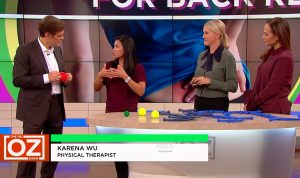 ActiveCare Physical Therapy, PC
ActiveCare Physical Therapy, PC
12 W 37th St. Ste. 1202
New York, NY 10018

Karena on the Today Show: Preventing & Treating Fall Injuries
Dr. Karena Wu joins the Today Show again for National Physical Therapy Month. October is National Physical Therapy Month and as fall rolls around, it is important to know how to prevent and treat fall injuries. In this segment on the Today Show, Dr. Karena Wu, an APTA Board-Certified Clinical Specialist in Orthopedic Physical Therapy discusses how to avoid injuries throughout the lifespan. This segment discusses prevention and treatment of fall injuries across the lifespan with some simple at home stretches and modalities.
Before outdoor activities or any sports exercises, dynamic stretches are a wonderful way to mimic the movement of the exercise to help move the soft tissues, bring blood flow, increase circulation and help prepare the body for movement. Dynamic stretches help the body warm up and stretch before activities and can help avoid injuries for people of all ages. For older folks, static stretches are great to help elongate the soft tissues around the joints. As we get older, we get more stiff and tight and less flexible. This type of stretch can help reduce any feelings of stiffness or aches and pains because the purpose of the static stretch is to lengthen the soft tissue. Lengthened tissues also function better and can help with activation and reactivity which is helpful in balance and prevention of falls.
When dealing with an injury, Dr. Wu discusses when to use ice and when to use heat. Ice is typically done after an acute injury and can be used up to 72 hours after an injury to help with pain, swelling and inflammation. Heat can be used with chronic or long standing injuries that also are more stiff dominant. The heat will increase blood flow to the area to make the tissues more pliable, reduce pain perception and increase mobility in the area.
Kinesiology tape is an at home tool that consumers can purchase over the counter. Dr. Wu is a Certified Kinesio Tape Practitioner and has worked as the Director of Education for SpiderTech Tape. Kinesiology tape is used after an injury but can be used preventatively as well. The tape can turn on muscles, turn off muscles, support areas and help with swelling. Individuals can learn how to tape themselves to help support any injury but can be limited by position and access when doing a tape job on themselves. For the best tape application, visit your local physical therapist to evaluate you for your condition and determine the best tape application for your condition.
